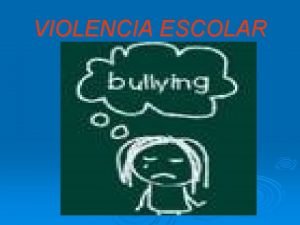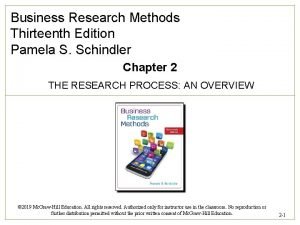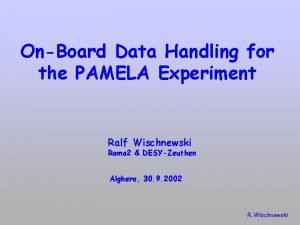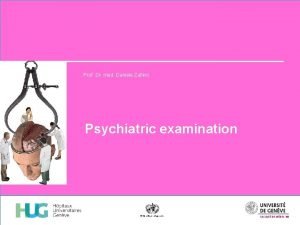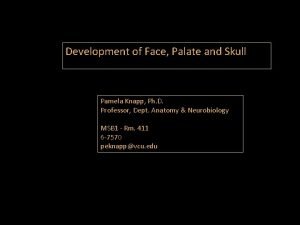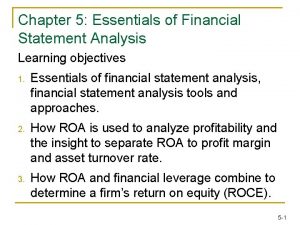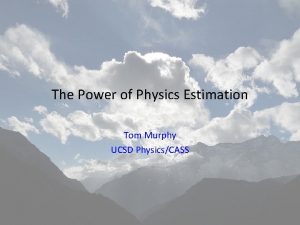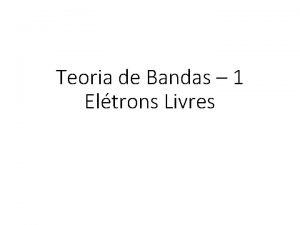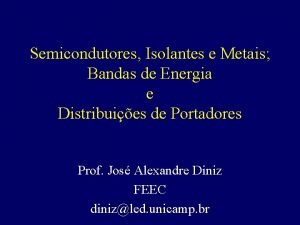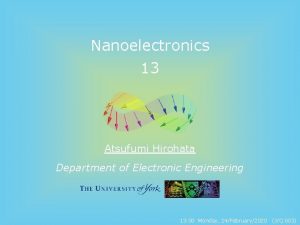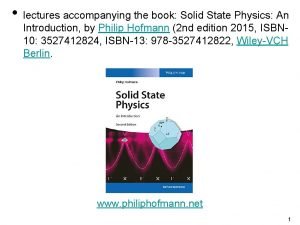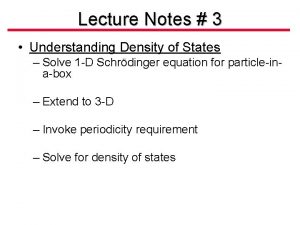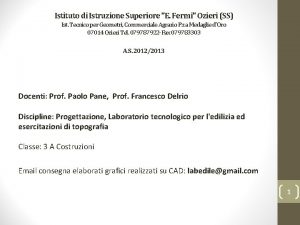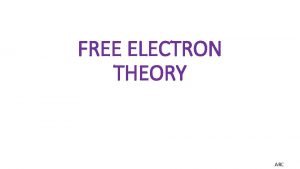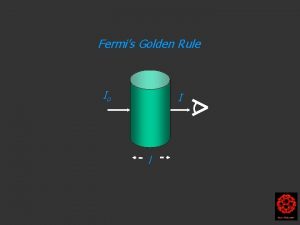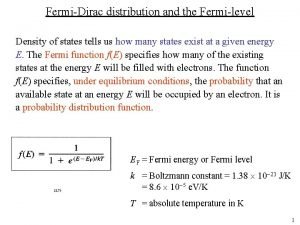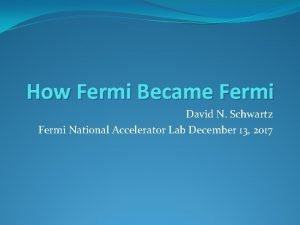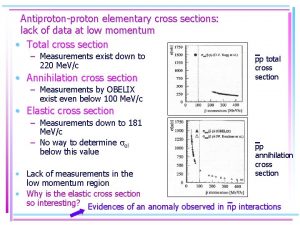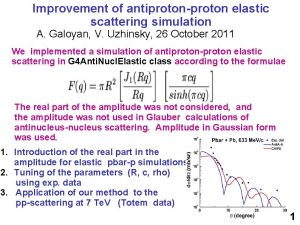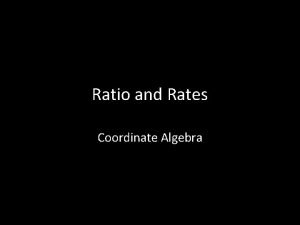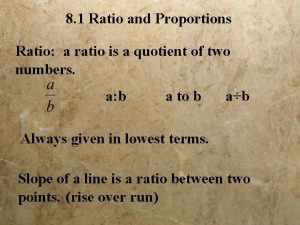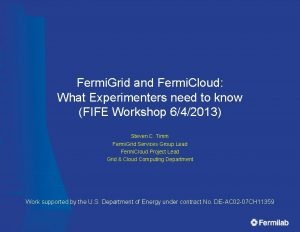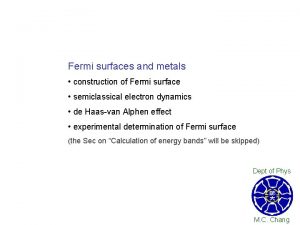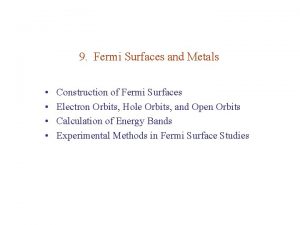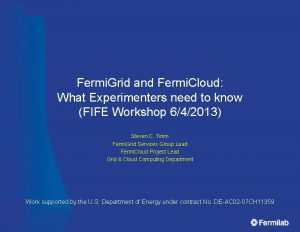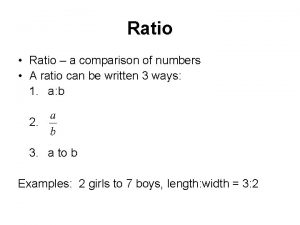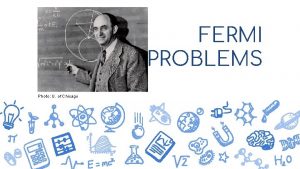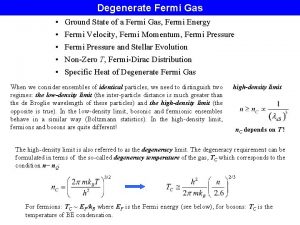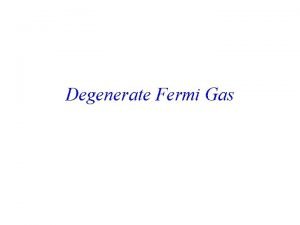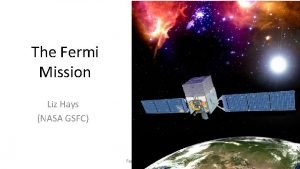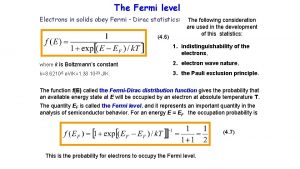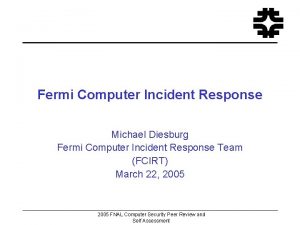Electronpositron ratio antiprotonproton ratio in PAMELA and Fermi























































- Slides: 55

Electron/positron ratio & antiproton/proton ratio in PAMELA and Fermi ROBERTA SPARVOLI UNIVERSITY OF ROME “TOR VERGATA” AND INFN MORIOND 2013: VERY HIGH ENERGY PHENOMENA IN THE UNIVERSE

Dark Matter searches Evidence for the existence of an unseen, “dark”, component in the energy density of the Universe comes from several independent observations at different length scales: Rotation curves of galaxies Galaxy clusters CMB Lensing Large Scale Structure SN Ia Bertone, Hooper & Silk, hep-ph/0404175, Bergstrom, hep-ph/0002126, Jungman et al, hep-ph/9506380

The “Concordance Model” of cosmology The “concordance model” of big bang cosmology attempts to explain cosmic microwave background observations, as well as large scale structure observations and supernovae observations of the accelerating expansion of the universe. tot = 1. 003 0. 010 m ~ 0. 22 [ b=0. 04] ~ 0. 74 Most of matter of non-baryonic nature and therefore “dark” !

Different data: �WD supernovae • CMB • Matter surveys all agree at one point

Dark matter candidates • Kaluza-Klein DM in UED • Kaluza-Klein DM in RS • Axion • Axino • Gravitino • Photino • SM Neutrino • Sterile Neutrino • Sneutrino • Light DM • Little Higgs DM • Wimpzillas • Q-balls • Mirror Matter • Champs (charged DM) • D-matter • Cryptons • Self-interacting • Superweakly interacting • Braneworld DM • Heavy neutrino • NEUTRALINO • Messenger States in GMSB • Branons • Chaplygin Gas • Split SUSY • Primordial Black Holes L. Roszkowski

DM candidates: WIMP’s ! SUSY particles ?

Neutralino as the CDM candidate Linear combination of the neutral gauge bosons B and W 3 and the neutral higgsinos H 1 and H 2. The neutralino is a good candidate because: • • • Stable (if R-parity is conserved) Mass: mc~ 10 -1000 Ge. V Non-relativistic at decoupling CDM Neutral & colourless Weakly interacting (WIMP) Good relic density

SIGNALS from RELIC WIMPs For a review, see i. e. Bergstrom hep-ph/0002126 Direct searches: elastic scattering of a WIMP off detector nuclei Measure of the recoil energy Indirect detection: in cosmic radiation Ø signals due to annihilation of accumulated in the centre of celestial bodies (Earth and Sun) neutrino flux Ø signals due to annihilation in the galactic halo neutrinos gamma-rays antiprotons, positrons, antideuterons PAMELA FERMI, AMS n and g keep directionality can be detected only if emitted from high density regions Charged particles diffuse in the galactic halo antimatter searched as rare components in cosmic rays

Neutralino annihilation Production takes place everywhere in the halo!! The presence of neutralino annihilation will destort the positron, antiproton and gamma energy spectrum from purely secondary production

Spectrum deformation

Another possible scenario: KK Dark Matter LIGHTEST KALUZA-KLEIN PARTICLE (LKP): B(1) Bosonic Dark Matter: fermionic final states no longer helicity suppressed. e+e- final states directly produced. As in the neutralino case there are 1 -loop processes that produces monoenergetic γ γ in the final state.

Kaluza-Klein Dark Matter in e+e. Direct annihilation of the Lightest Kaluza-Klein particle (LKP) into electron-positron pair in the Galactic halo (Baltz and Hooper, JCAP 7, 2007, and references therein) e- + e+ yield is estimated to be ~20% per annihilation Could be a unique opportunity to observe a sharp feature in the electron spectrum (predicted in some models)

First hint of something new: results from ATIC (Nature, 2008)

PAMELA positron fraction (Nature 2009)

FERMI All-Electron Spectrum (PRL 2009) FERMI e+ + e- flux (2009)

Electrons measured with H. E. S. S. (2009)

PAMELA

Adriani et al. , Nature 458 (2009) 607 Adriani et al. , AP 34 (2010) 1 (new results) Positron fraction § Low energy charge-dependent solar modulation (see tomorrow) § High energy (quite robust) evidence of positron excess above 10 Ge. V (Moskalenko & Strong 1998) GALPROP code • Plain diffusion model • Interstellar spectra

Adriani et al. , Nature 458 (2009) 607 Adriani et al. , AP 34 (2010) 1 (new results) Positron fraction § Low energy charge-dependent solar modulation (see tomorrow) § High energy (quite robust) evidence of positron excess above 10 Ge. V (Moskalenko & Strong 1998) GALPROP code • Plain diffusion model • Interstellar spectra

New positron fraction data Using all data till 2010 and multivariate classification algorithms about factor 2 increase in positron statistics respect to published analysis

New positron flux

Largest energy range covered so far ! Adriani et al. - PRL 105 (2010) 121101 Antiproton flux

Adriani et al. - PRL 105 (2010) 121101 Antiproton-toproton ratio Largest energy range covered so far !

New antiproton flux –> 400 Ge. V Using all data till 2010 and multivariate classification algorithms 40% increase in antip respect to published analysis (Donato et al. 2009) • Diffusion model with convection and reacceleration • Plain Diffusion Model (Ptuskin 2006)

A challenging puzzle for CR physicists Antiprotons Positrons Consistent with pure secondary production Evidence for an excess

Positron-excess interpretations (Cholis et al. 2009) Contribution from DM annihilation. Dark matter § boost factor required § lepton vs hadron yield must be consistent with pbar observation Astrophysical processes • known processes • large uncertainties on environmental parameters (Blasi 2009) e+ (and e-) produced as secondaries in the CR acceleration sites (e. g. SNR) (Hooper, Blasi and Serpico, 2009) contribution from diffuse mature & nearby young pulsars.

Interpretation: DM M. Cirelli et al. , Nucl. Phys. B 813 (2009) 1; ar. Xiv: 0809. 2409 v 3 Which DM spectra can fit the data? DM with and dominant annihilation channel (possible candidate: Wino) positrons ! s Ye antiprotons N o!

Interpretation: DM M. Cirelli et al. , Nucl. Phys. B 813 (2009) 1; ar. Xiv: 0809. 2409 v 3 Which DM spectra can fit the data? DM with and dominant annihilation channel (no “natural” SUSY candidate) But B≈104 positrons Y ! s e antiprotons ! s Ye

Interpretation: DM M. Cirelli et al. , Nucl. Phys. B 813 (2009) 1; ar. Xiv: 0809. 2409 v 3 DM with channel and dominant annihilation positrons ! s Ye antiprotons ! s e Y ! s Ye

Interpretation: DM I. Cholis et al. Phys. Rev. D 80 (2009) 123518; ar. Xiv: 0811. 3641 v 1

Astrophysical Explanation: secondaries in SNR Positrons (and electrons) produced as secondaries in the sources (e. g. SNR) where CRs are accelerated. But also other secondaries are produced: significant increase expected in the p/p and B/C ratios. P. Blasi et al. , PRL 103 (2009) 051104 ar. Xiv: 0903. 2794

New antiproton/pr oton ratio 400 Ge. V Overall agreement with models of pure secondary calculations for solar minimum (constraints at low and high energy for DM models!) The solid line shows a calculation for secondary antiprotons including an additional antiproton component produced and accelerated at cosmic-ray sources.

Astrophysical Explanation: Pulsars Are there “standard” astrophysical explanations of the high energy positron data? Young, nearby pulsars Geminga pulsar Not a new idea: Boulares, Ap. J 342 (1989), Atoyan et al (1995)

Astrophysical Explanation: Pulsars � Mechanism: the spinning B of the pulsar strips e- that accelerated at the polar cap or at the outer gap emit γ that make production of e± that are trapped in the cloud, further accelerated and later released at τ ~ 105 years. � Young (T < 105 years) and nearby (< 1 kpc) � If not: too much diffusion, low energy, too low flux. � Geminga: 157 parsecs from Earth and 370, 000 years old � B 0656+14: 290 parsecs from Earth and 110, 000 years old. � Diffuse mature pulsars

Astrophysical Explanation: Pulsars H. Yüksak et al. , ar. Xiv: 0810. 2784 v 2 Contributions of e- & e+ from Geminga assuming different distance, age and energetic of the pulsar Mirko Boezio, Innsbruck, 2012/05/29 diffuse mature &nearby young pulsars Hooper, Blasi, and Serpico ar. Xiv: 0810. 1527

How to clarify the matter? Courtesy of J. Edsjo

(Strong & Moskalenko 1998) GALPROP code (Kane et al. 2009) • Annihilation of 180 Ge. V wino-like neutralino consistent with PAMELA positron data • Large uncertainties on propagation parameters allows to accommodate an additional component • A p-bar rise above 200 Ge. V is not excluded (Donato et al. 2009) • Diffusion model with convection and reacceleration (Blasi & Serpico 2009) • p-bar produced as secondaries in the CR acceleration sites (e. g. SNR) consistent with PAMELA positron data Adriani et al. - PRL 105 (2010) 121101 Positrons vs antiprotons +

Theoretical uncertainties on “standard” positron fraction γ = 3. 54 γ = 3. 34 Flux=A • E- T. Delahaye et al. , Astron. Astrophys. 501 (2009) 821; ar. Xiv: 0809. 5268 v 3

Electron energy measurements Adriani et al. , PRL 106, 201101 (2011) spectrometer Two independent ways to determine electron energy: 1. Spectrometer • • Most precise Non-negligible energy losses (bremsstrahlung) above the spectrometer unfolding calorimeter 2. Calorimeter • • • Gaussian resolution No energy-loss correction required Strong containment requirements smaller statistical sample Electron identification: • Negative curvature in the spectrometer • EM-like interaction pattern in the calorimeter

Electron absolute flux e- Adriani et al. , PRL 106, 201101 (2011) § Largest energy range covered in any experiment hitherto with no atmospheric overburden § Low energy • minimum solar activity (f = 450÷ 550 GV) § High energy § No significant disagreement with recent ATIC and Fermi data § Softer spectrum consistent with both systematics and growing positron component Spectrometric measurement Calorimetric measurements Flux=A • E - = 3. 18 ± 0. 04 e+ +e-

PAMELA Electron & Positron Spectra Pr eli m ina ry Flux=A • E- = 3. 18 ± 0. 04 Flux=A • E- = 2. 70 ± 0. 15

FERMI OBSERVATORY










PAMELA & FERMI • Same trend for positrons (increasing with energy) • Compatible spectral indexes for electrons and positrons : PAMELA : FERMI: = 3. 18 ± 0. 04 for electrons = 2. 70 ± 0. 15 for positrons = 3. 19 ± 0. 07 for electrons = 2. 77 ± 0. 14 for positrons

Conclusions �Electron/Positron data have opened new physics in Cosmic Rays in the last 5 years; ATIC, FERMI, PAMELA measurements all pointed towards an excess. �Evident excess in the electron and positron (and therefore in the all-electron) spectra revealed the presence of a leptonic new source; �The contemporary absence of a hadronic new source, as shown by the PAMELA antiproton data, seems to point towards a astrophysical source rather than to dark matter. BUT ….

Conclusions �Recent rumors by AMS – not yet supported by an official paper - make us guess that the DM interpretation might play a role again. �“Big news in the search for dark matter may be coming in about two weeks”, Ting said at the annual meeting of the American Association for the Advancement of Science. “That's when the first paper of results from AMS will be submitted to a journal”. �“It will not be a minor paper" Ting said, hinting that the findings were important enough that the scientists rewrote the paper 30 times before they were satisfied with it …

Conclusions �Apart from AMS data, the new CALET mission (Japan-Italy-US) will perform high statistics measurements of electrons up to 10 Te. V; �Built around a 30 r. l. calomiter, it will be mounted on the ISS in 2 o 14; �With its good geometrical factor, it will improve significantly the systematic uncertainties of previous calorimetric measurements.
 Pamela pizarro alvarez
Pamela pizarro alvarez Dra pamela santos
Dra pamela santos Pamela thielman
Pamela thielman Pamela tossati
Pamela tossati Pamela goldberg
Pamela goldberg Pamela peretti
Pamela peretti Pamela elizabeth modica
Pamela elizabeth modica Pamela nicoara
Pamela nicoara Pamela aray
Pamela aray Snapshot
Snapshot Dr pamela beck
Dr pamela beck Pamela guest
Pamela guest Pam nicholson net worth
Pam nicholson net worth Pamela schwartz
Pamela schwartz Pamela fishman gender theory
Pamela fishman gender theory Pamela harman
Pamela harman Christy henrich
Christy henrich Pamela cox bryant
Pamela cox bryant Pamela weber harris
Pamela weber harris Pamela ralf
Pamela ralf Aroma siez young living usos
Aroma siez young living usos Vignette style mcq
Vignette style mcq Euclideon unlimited detail
Euclideon unlimited detail Pamela hines science
Pamela hines science Pamela zullino
Pamela zullino Ego syntonic
Ego syntonic Pamela knapp
Pamela knapp Pamela parada
Pamela parada Pamela caillens
Pamela caillens Pamela nicoara
Pamela nicoara Motivationsbedingte fehlzeiten
Motivationsbedingte fehlzeiten Pamela elizabeth modica
Pamela elizabeth modica Pamela currie
Pamela currie Pamela arenas
Pamela arenas Pamela jeziorska-biel
Pamela jeziorska-biel Pamela c. cosman
Pamela c. cosman Pamela pompa
Pamela pompa Pamela carver
Pamela carver Dr pamela kum
Dr pamela kum Matter of quilantan
Matter of quilantan Acid test ratio and quick ratio
Acid test ratio and quick ratio Phenotypic ratio in dihybrid cross
Phenotypic ratio in dihybrid cross Current ratio and quick ratio
Current ratio and quick ratio Tom murphy do the math
Tom murphy do the math Teoria de bandas
Teoria de bandas Metais
Metais Atsufumi hirohata
Atsufumi hirohata Formula of mean free path
Formula of mean free path Intrinsic carrier concentration
Intrinsic carrier concentration Fgenera
Fgenera Iis fermi ozieri
Iis fermi ozieri Fermi bubbles
Fermi bubbles Merits of classical free electron theory
Merits of classical free electron theory Fermi golden rule
Fermi golden rule Fermilavel
Fermilavel Fermi dirac distribution at t=0
Fermi dirac distribution at t=0
